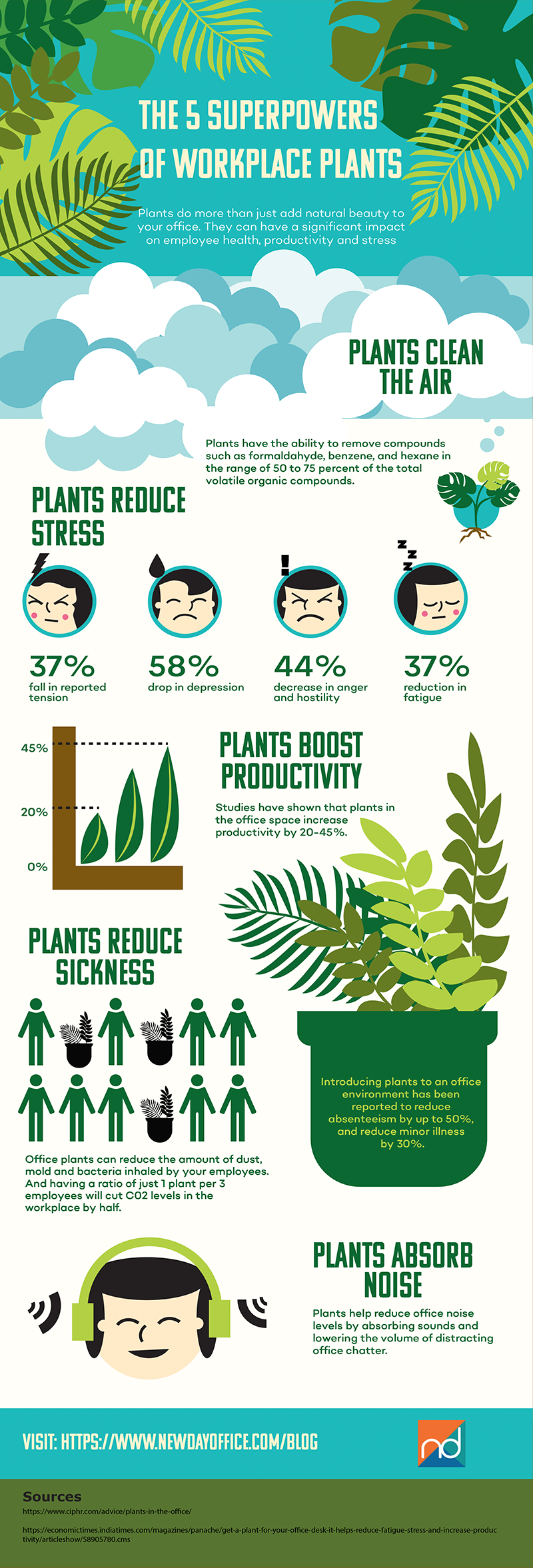BIOPHILIC DESIGN-CONNECTING WITH NATURE TO IMPROVE HEALTH AND WELL-BEING
What is biophilia?
Plants provide a connection to the natural world, which is referred to as biophilia. Researchers found that our physical and mental well-being increases with the presence of natural greenery. Productivity, creativity, and problem-solving are a result of having plants integrated into the workspace. Plants are great for screening for defining different zones and for social distancing.
Plants purify the indoor air of toxins introduced into buildings with common building materials, such as flooring adhesives and paint, by trapping particulate matter and carbon dioxide gasses from the air and at the same time, releasing oxygen. Many of these toxins are known carcinogens, like formaldehyde and benzene. Other toxins may induce symptoms such as headaches, chronic fatigue, asthma, and other respiratory problems. Research conducted by Dr. William Wolverton of NASA indicated that many volatile organic compounds including benzene, toluene, formaldehyde, carbon monoxide, and trichloroethylene can have their levels greatly reduced by even a few houseplants. Beyond purifying toxins from the air, plants emit oxygen through their natural process of photosynthesis. This increase in oxygen helps to keep us healthy and alert.
Benefits of Biophilic Design
The results of a research study conducted by the Healthy Building Program at the Harvard T.H. Chan School of Public Health suggests that biophilic interventions can help reduce stress and improve creativity. The study measured blood pressure, heart rate, heart rate variability, and the body’s reaction to stress while cognitive tests were administered to measure participants’ reaction time and creativity. Participants in the spaces with biophilic elements had consistently lower physiological stress indicators, as well as higher creativity scores. Green plants in hospital environments have shown increased recovery times and reduced demand for pain medication.
“When people return to the workplace, they will be doing so with an understanding that the physical space will be safe and supportive of their holistic wellbeing,” said Heather Greene, senior associate and workplace leader at Stantec. “Prioritizing health and wellness in design is critical to teams reaching their full potential and maintaining a high level of engagement.”
WHY IS BIOPHILIC DESIGN RELEVANT TODAY?

Incorporating direct or indirect elements of nature into the built environment have been demonstrated through research to reduce stress, blood pressure levels, and heart rates, and increase productivity, creativity, and self-reported rates of well-being.
Increased productivity
Various studies have shown that including plants in workplace design can have a positive effect on perceived productivity.
- Two-thirds (58%) of workers have no live plants in their workspaces. Those working in environments incorporating natural elements reported a 15% higher wellbeing score and 6% higher productivity score than employees whose offices didn’t.
Reduced stress
We often gravitate to the great outdoors to calm and soothe ourselves when we need to relax and re-charge.
- Incorporating plants into workplaces is just one way of reconnecting with nature and bringing the outdoor world inside
- Studies show daily interaction with plants helps reduce psychological and physiological stress
Reduced absenteeism
Plants in office spaces can help create healthier working environments.
- Plants help remove toxins in the environment
- Clean air helps reduce employee sickness working in a healthier environment
- Offices embracing nature have seen a 26% boost in cognition and a 30% drop in sickness-related absences among employees
Reduced noise levels
Open-plan offices can lead to a high volume of noise and acoustic pollution as well as a lack of privacy.
- Plants help absorb ambient noise due to their numerous and varied leaf surfaces
- Moss walls have significant acoustic properties
BIOPHILIA IN OFFICE DESIGN
- Prevents fatigue when completing tasks that demand high levels of attention
- Speeds up call processing by 6-12%
- Increased performance by 10% to 25% on tests of mental function and memory recall
- Increased wellbeing by 15%, productivity by 6%, and creativity by 15%
- Reduced absenteeism by 15%
- Greenery in the office, such as plants and green walls, was associated with higher levels of creativity
- Absence of greenery was associated with higher levels of employee stress
- Workspaces where individuals had no natural light or greenery report higher levels of sickness
BIOPHILIA IN EDUCATIONAL INSTITUTIONS
- Increased speed of learning by 20-26%
- Improved attendance by an average of 3.5days/year
- Improved test scores by 5-14%.
- Enhanced cognitive abilities and increased ability to focus
- Reduced symptoms of Attention Deficit Disorder (ADD)
- Reduced stress
BIOPHILIA IN THE HOSPITALITY INDUSTRY
- Hotel guests spend 36% more time in biophilic designed hotel lobbies than conventional lobbies spending more time and money inside the hotel
- Hotels charge more for rooms with views to natural landscapes, as guests show a preference for views and request them







